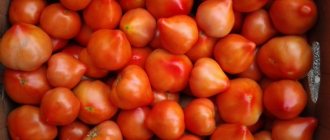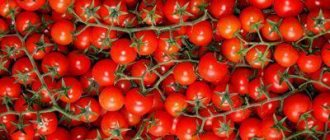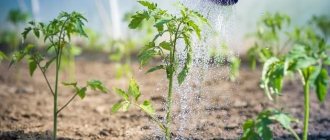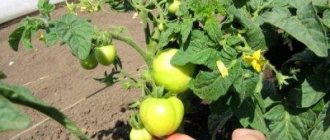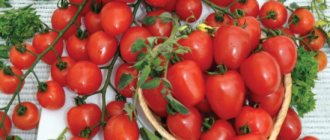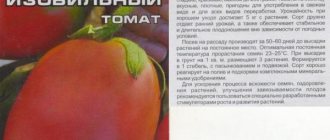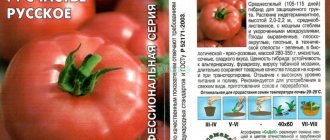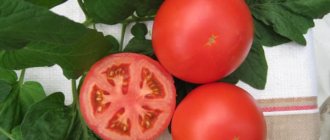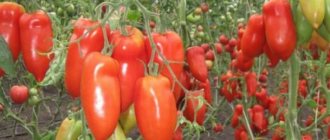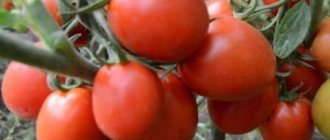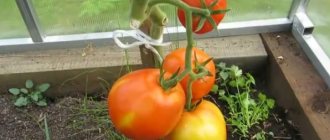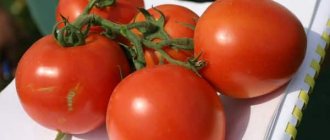| Ripening period: | early ripening (90-95 days) |
| Shape, weight of fruits: | flat-round, weighing up to 200 g |
| Determinacy: | height 70-90 cm |
| Growing regions: | indoors and outdoors throughout the country |
| Productivity: | 5-6 kg per bush |
Hundreds of low-growing varieties and hybrids have been created for growing tomatoes in open ground. They are inferior in yield to indeterminate plants, but they are easy to care for. The Polbig tomato variety is loved by gardeners for its compact size, unpretentiousness and productivity.
Description of tomato variety Polbig
Tomato Polbig F1 is a plant with an ultra-early ripening period. The first fruits appear 60 days after transferring the seedlings to a permanent growing location. The bushes are compact, of a determinant type of growth, which means independent topping of the main stem at a height of 60-80 cm. Further fruit formation occurs on the side shoots. The leaves are medium to large in size, green or light green in color. The foliage is moderate. The inflorescences are simple.
The leaves of the plant are resistant to sunburn
Tomato Polbig is recommended for open ground. It is distinguished by its ability to set fruit at low temperatures. It is a first-generation hybrid and shows high resistance to fungal diseases. Bears fruits of excellent commercial quality.
Description of fruits
Polbig tomatoes grow the same size, weighing 180-200 g. The shape is flat-round, the skin is of good density and does not crack. Tomatoes ripen well and are colored from the inside. The ribbing is weakly expressed.
The hybrid has a high percentage of marketable fruit yield
Unripe tomatoes have a light green color, while ripe ones have a smooth, red color. The peduncle is articulated, the green spot is absent. Polbig tomatoes are formed on a bunch of 6-8 pcs. The fruits are uniform in size, including those that form on the side shoots.
Inside, the tomato contains few seeds, with a predominance of pulp. The taste is excellent. There is aroma and juiciness. Tolerates transportation well. Keeping quality is high, in suitable conditions – up to 1-3 weeks.
Aligned and beautiful fruits are suitable for commercial cultivation.
Characteristics and description of the variety
The characteristics and description of the hybrid variety Polbig give the following parameters:
- The bush is powerful, with a thick trunk, about 80 cm high in open ground, up to 130 cm in a greenhouse. Despite its short stature, the Polbig tomato needs to be tied to a support so that the clusters of fruit do not break the plant.
- The leaves are few in number, light green, medium in size, without pubescence. The flower brush is laid after the 5th true leaf. The flowering of the hybrid is characterized by the absence of barren flowers. There are 4-6 fruits in a tomato cluster.
- Polbig tomatoes are round in shape, large specimens are slightly flattened. The skin color is bright red. The weight of the fruit ranges from 100 to 220 g; traditionally large tomatoes are borne on the lower clusters. They are characterized by dense pulp and the sweet and sour taste inherent in tomatoes. The thick skin allows the harvest to be preserved for several weeks.
- Tomato Polbig F1 belongs to early ripening hybrids. The first red fruits can be harvested 90 days after sowing the seeds in the ground. Under favorable weather conditions and proper agricultural technology, 6 kg of large tomatoes can be harvested from each bush of a hybrid plant.
- Tomatoes are eaten in salads, pickled, tomato puree, lecho, and vegetable stew are prepared.
You can evaluate the appearance of the Polbig hybrid from the photos presented.
Characteristics of Polbig tomato
The Polbig tomato grows as a low-growing bush, which is formed into 2-3 trunks. The stem independently completes growth when a flower raceme forms at the top. During cultivation, gartering and partial pinching are necessary. The bush forms a powerful, resistant to cold and fungal infections. Tomatoes are cultivated in open ground on private and small farms. Well transported due to the density of the fruit.
In the middle zone and Northern regions, Polbig tomato is recommended to be grown on warm and raised ridges protected by film shelters from bad weather.
Advice! To obtain the earliest harvest, the Polbig hybrid is grown through seedlings.
Planting by direct seeding into the soil is also possible. The plant is characterized as unpretentious and easy to care for. Under suitable growing conditions and compliance with agricultural technology, it shows high, stable yields. The variety is responsive to regular feeding.
Polbig tomato yield and fruiting
The yield in open ground is 4-4.5 kg per plant. Tomatoes ripen early - the first fruits turn red three months after the sprouts appear. The yield is affected by the planting area and the regularity of microelements. Fewer tomatoes may set in clusters if the weather becomes hot during the pollination period.
Area of application of fruits
Polbig tomatoes have a pleasant taste and are best suited for preparing fresh salads.
For preservation, tomatoes are used in cut form, because their large size is not always suitable for whole-fruit pickling.
The presence of a large amount of fleshy pulp inside tomatoes allows them to be used to make sauces and pastes.
Resistance to diseases and pests
The culture is resistant to diseases such as verticillium and fusarium. Due to the fact that the fruits appear very early, the plants do not fall into the peak of late blight. To prevent other diseases, it is necessary to carry out fungicide treatments.
Features of care
The Polbig variety requires standard care, which is provided to tomatoes. This includes watering, fertilizing, and weeding the beds. Additionally, the bush is pinched and formed into two stems. As reviews of the Polbig F1 tomato show, it is an unpretentious plant that is resistant to temperature changes and other unfavorable conditions.
Watering the plantings
Tomatoes are provided with moderate watering to maintain soil moisture at 90%. Plants are watered in the morning or evening, when there is no direct sunlight. Moisture is introduced at the root; it is important to prevent it from getting on the leaves and trunk.
Advice! For irrigation, use warm, pre-settled water.
Tomatoes are watered once or twice a week depending on weather conditions. Approximately 3 liters of water are added to each bush. You can water the plantings manually using a watering can or install drip irrigation. Such a system includes several pipelines through which moisture is sequentially supplied.
After planting the variety in a greenhouse or soil, water it abundantly, after which the procedures are resumed only after 10 days. During this time, the seedlings take root. During the flowering period of tomatoes, the volume of water for irrigation is increased to 5 liters.
Fertilizer application
The Polbig tomato responds well to fertilization. For active growth, plants require phosphorus, which allows them to form a strong root system. It is added using superphosphate. Another important microelement for tomatoes is potassium, which increases immunity and improves the taste of the fruit. Plants are provided with them by adding potassium sulphide.
Important! Tomatoes can be fed with complex fertilizer containing the necessary proportions of nutrients.
Instead of mineral fertilizers, you can use folk remedies: feed the tomatoes with ash or yeast. If the plants develop poorly, then they are watered with mullein or herbal infusion. This fertilizing will provide the plants with nitrogen and accelerate the growth of green mass. When inflorescences appear, nitrogen application is stopped so as not to stimulate shoot growth to the detriment of fruit formation.
Feeding is carried out in several stages:
- Before flowering begins (nitrogen-containing products can be used).
- When the first inflorescences appear (phosphorus is added).
- During the fruiting process (potassium supplements are applied).
Advantages and disadvantages of the variety
The Polbig tomato has undergone variety testing in the Russian climate and is suitable for cultivation in all regions.
pros
- cold-resistant;
- precocious;
- low compact bush;
- pleasant taste;
- high content of vitamins;
- a large amount of pulp;
- uniform size of fruits;
- in the southern regions it is possible to grow by direct sowing into the soil;
- universal purpose, fruits are ideal for processing;
- resistance to certain diseases.
Minuses
- The culture does not reproduce with its own seeds, only purchased material;
- pollination stops at temperatures above +32°C.
Agricultural technology
To reap a high harvest, you need to pay attention to cultivating seedlings. Tomato is grown in seedlings. Seeds are germinated in small containers filled with soil mixture.
After sowing, moisten the soil and move the container to a warm and well-lit place. To ensure the friendly appearance of sprouts, maintain an optimal air temperature of +25...+27 °C.
After the formation of 2-3 leaves, the seedlings are planted in separate containers. 10-14 days before planting in the ground, Polbig f1 tomatoes are hardened by a short stay in the fresh air.
2 months after the sprouts appear, the tomatoes are planted in a permanent place. When cultivated indoors, planting is carried out 1 week earlier. When planting crops, crop rotation is taken into account; the plants are placed in a well-lit area.
Humus and mineral fertilizers are added to each hole. When planting in a permanent place, 5-6 bushes are placed per 1 m² at a distance of 40-50 cm from each other.
The rules for caring for tomatoes in open ground provide for a system of measures that include:
- periodic loosening of the soil;
- hilling bushes;
- bush formation;
- removal of stepsons;
- moderate watering with warm water;
- soil mulching.
You can speed up the formation of ovaries using the drug Mortar, which is used to treat plants.
Features of cultivation
Polbig tomato seedlings are kept indoors or in a greenhouse. A low-growing hybrid should not outgrow during this period. Therefore, sowing begins 40-45 days before transplanting to a permanent location. In this case, plants adapt faster to new conditions.
For germination, take fertile, loose soil that is uniform in structure. The planting containers are filled with it, and a few days before sowing the soil is disinfected with a Fitosporin solution.
Before planting, the soil is moistened and compacted. The holes for sowing are made no more than 0.5 cm deep, the seeds are laid out at a distance of 2 cm from each other. Cover the top with a thin layer of soil and also press lightly.
Planting containers must have a drainage hole
Until the first shoots appear, the crops are kept at elevated temperatures - about +25... +28°C. Then it is reduced to + 18°C for one week, which promotes the formation of strong roots. Lighting for hatched seedlings is immediately increased by supplementary lighting with special lamps.
Tomatoes should receive 14 hours of light per day with a break at night.
To water the seedlings, it is recommended to use melted snow or rainwater heated to a temperature of +25°C. Plants with 2-3 leaves dive.
For planting in open ground, the soil is moistened, loosened, and deoxidizing components are added. Add 10 g of superphosphate to each well. They are placed at a distance of 50 cm in a row and from each other.
In open ground, as in a greenhouse, it is recommended to cover the soil with dark non-woven material or film before planting. This method creates the necessary microclimate, and the tomatoes on the lower branches remain clean.
When growing with dark mulching material, it is necessary to carry out drip irrigation under it.
The product is stretched well, holes are cut for planting.
Advice! The mulching material is covered with soil along the edges so that there is no room for weeds to develop.
Plants need to be staked as they grow. The main stem is attached with a free loop to the stakes or tied with a cord and secured to the trellis. To avoid breakage, fruiting shoots also need support.
The Polbig tomato is watered infrequently. When growing, it is best to use drip irrigation, which also supplies nutrients. Mineral elements are especially necessary for the crop during the period of fruit setting and coloring.
Main characteristics
Also check out these articles
- Strawberry jam
- How to make gardening work easier: drip irrigation and other life hacks
- The best varieties of gooseberries
- Grape variety Anyuta
Each tomato variety or hybrid has its own special characteristics that set it apart. What features does the Polbig F1 hybrid have?
Hybrid Polbig F1
- Early ripening.
- Cold-resistant - it is not afraid of late frosts.
- The fruits do not crack and are stored for a long time.
- Transportability is good; during transportation, the fruits do not wrinkle or deteriorate if they are stacked correctly.
- The hybrid is immune to fusarium and verticillium. Not affected by late blight due to early fruit ripening.
- The yield per square planting reaches 5.7 kg, but only with good agricultural technology.
Interesting!
Treatment of bushes with “Rastvorin” or “Kemira” can speed up the formation of fruits. But they must be used strictly according to the instructions, so as not to harm the quality and taste of the future harvest.
- The taste of tomatoes is excellent both fresh and canned.
- Due to the significant height of the bush, a garter to a trellis or pegs is necessary.
The main advantages and disadvantages of the Polbig F1 tomato
The Polbig variety has a number of features that you need to familiarize yourself with before you start growing it. The main advantages of the variety include:
- early ripening of fruits;
- resistance to low temperatures;
- productivity;
- resistance to most diseases;
- good transportability.
Meanwhile, the disadvantages noted by gardeners should also be taken into account:
- weak taste of ripe fruits;
- the need for pinching and bush formation;
- obligatory garter of the stem and brushes.
The variety is suitable for cultivation both in open ground and in greenhouses. Due to its ability to form ovaries even at low temperatures, Polbig can be successfully cultivated in regions with cool summers.
Such hybrid tomato varieties as Platinum “F1”, Polyus and Prima Lux “F1” have similar varietal characteristics.
Reviews
Gardeners praise tomatoes for their early harvest, large number of fruits, unpretentiousness, powerful bushes, and excellent fruit set. We are also pleased with the 100% yield in any weather; the variety is suitable for most regions.
Most vegetable growers choose this particular variety to be sure to have a harvest, because... it is distinguished by its reliability, resistance to disease, and with it you can be sure that your work was not in vain.
But there are also negative reviews. For the most part, they are related to the taste of tomatoes. Some summer residents even call them plastic. But there are also claims that the fruits are excellent for canning, here they already have an excellent taste.
Tomatoes "Polbig F1" have good shelf life, so they are excellent for sale
When choosing a Polbig tomato, you should consider your goals. If you need tomatoes with a bright, rich taste for yourself, for personal use, then most likely you are better off choosing a different variety. But again, if you are interested in yield and are going to use the fruits for preservation, then the choice will be good. But for sale this will be an amazing option. It will delight you with the quantity of beautiful fruits, very early ripeness, increased commercial qualities, keeping quality and transportability. With this tomato you will get good profit.
How to grow tomato seedlings yourself
Having decided to plant an expensive hybrid from the Netherlands on your plot, you need to come to terms with the fact that the seedlings of such a tomato will need to be grown yourself. Since it is impossible to determine the varietal identity of a plant by the appearance of a young bush, seedlings of valuable hybrids are rarely grown for sale, and having found a similar product on the market, you can never be sure that the plant corresponds to the declared characteristics.
Optimal timing for sowing
You should never rush to sow tomato seedlings.
Important! Too small bushes, once in open ground, will form and gain strength quickly enough, but overgrown seedlings, on the contrary, take root very difficultly.
Depending on the climatic zone, you need to sow the seeds from early March to early April, so that on average about two months remain until the bushes are transplanted into open ground. You should always remember that tomatoes germinate and develop much faster than other representatives of nightshades (for example, eggplants, sweet and bitter peppers), so you need to plant tomatoes about 2-3 weeks later than other vegetables.
The soil
When choosing soil for seedlings, you can act in two ways, each of which has its own advantages and disadvantages:
- buy ready-made substrate for seedlings;
- Prepare your own soil mixture.
In the first case, the soil does not require additional treatment, it obviously contains everything necessary for the normal development of a young plant and, on the contrary, it definitely does not contain spores of pathogenic fungi, pest larvae, as well as bacteria or viruses.
Video: Soil for seedlings
However, gardeners note that seedlings in open ground take root much better if the seeds are sown in soil similar to that where the adult plant will be located.
From this point of view, it is better to prepare the soil mixture yourself. For the hybrid Polbig f1, a suitable substrate is made up of a mixture of equal parts of only two components - garden soil and peat. Did you know? The smallest tomatoes in the world today are grown by an Israeli company called Kedma. These fruits are smaller in size than a local one shekel coin (15 mm), and in color they can be red or yellow. It is interesting that this tomato was not bred in Israel, but in the Netherlands, but the Dutch did a good job of adapting their creation to the hot and dry climate of the Promised Land.
The prepared soil mixture must be disinfected. There are three possible methods for this:
- Freezing. It is carried out in several stages. First, the container with soil is taken out into severe frost (at least -10 °C) for 10–12 hours, then returned to a warm room and left for another similar time. It is necessary that all pests in the soil, once in the warmth after frost, “perceive” such a change as the arrival of spring and come out of hibernation. Then the substrate is again taken out into the cold, where it is kept for at least a day. During this time, the majority of harmful microflora should die. To be on the safe side, you can repeat the procedure several times.
- Calcination. The substrate for seedlings is poured onto a baking sheet and placed in an oven preheated to +70 °C for several hours. It is not recommended to use a higher temperature, since too hot air can destroy not only harmful, but also beneficial microorganisms.
- Treatment with a disinfectant solution. A weak solution of potassium permanganate is usually used as such an antiseptic. The soil mixture is watered generously, after which you just need to let the liquid evaporate.
Growing container
There are several types of containers for growing seedlings. For these purposes the following can be used:
- shallow boxes, boxes or other similar containers;
- disposable cups;
- special cassettes for seedlings;
- peat tablets.
You can select a container at your own discretion, the only important thing is that the container must have a hole for draining excess moisture (for example, when using boxes or cups, such holes must first be made).
Cassettes with holes to drain excess moisture The seeds of the Dutch hybrid Polbig f1 have very good germination, so when planting them as seedlings, it is most convenient to use ready-made cassettes, placing one seed in each cell. In this case, when the sprouts are subsequently planted into a larger container (for the normal formation of the root system, a young tomato in the last stages of seedling cultivation requires approximately 30 cubic centimeters of soil layer), the plant will not be at risk of damaging the delicate root system, since the movement can be carried out together with the soil lumpy.
Seed preparation
Agricultural technology for growing seedlings of most varietal tomatoes and many hybrids involves carrying out serious preparatory work with seeds - sorting, soaking in growth stimulants, dressing, hardening. Polbig f1 does not need such procedures.
Important! The company produces for sale seed material of hybrid tomatoes that has undergone complete pre-sowing treatment. Such seeds are planted in the ground dry, immediately after being removed from the envelope.
Taking into account the high cost of seeds and the reputation of their manufacturer, specimens that do not retain a living embryo are also selected at the packaging stage, so with the maximum probability, each seed will form a full-fledged plant without any additional preparation. Moreover, any disinfecting, nutritional and hardening procedures can only harm the seed material, oversaturating it with additional substances that were not planned by the manufacturer.
Sowing seeds
The scheme for planting tomato seeds in seedlings is always standard. The depth of the bookmark is 1 cm, the distance between individual copies (if flat boxes or boxes are used, and not individual cassettes) is approximately 3 cm.
It is better to organize the sowing procedure as follows:
- Pour soil into the prepared containers in a volume 10 mm less than planned.
- It is very good to water the soil with slightly warmed water and allow excess moisture to escape through the drainage holes.
- Carefully, for example, using the tip of a knife, place the seeds in a given pattern directly onto the surface of the soil.
- Sprinkle the container with a centimeter layer of substrate.
- Using a spray bottle, carefully spray the surface of the soil, but under no circumstances water it, so as not to bury the seeds.
Video: Sowing seeds for seedlings
Seedling care
Containers with seedlings should be covered with film or covered with glass to create a greenhouse effect and placed in a warm (+25...+27 °C) and very bright place. Periodically, the film should be removed to ventilate the soil, and the top layer of the substrate should be carefully sprayed with a spray bottle.
After the first shoots appear (approximately on the fifth or sixth day after planting), the film is gradually removed. First, the shelter should be removed for several hours during the day and returned to its place at night, then increase this time and only then remove it completely.
Sprouted seedlings are transferred to a cooler (+20...+22 °C), but still well-lit place for growing.
Important! The optimal length of daylight for good formation of tomato seedlings should be at least twelve hours, however, modern agrotechnical methods require round-the-clock supplementary lighting of young seedlings during the first three days after germination.
Young tomato seedlings need to be watered abundantly, but at the same time adhere to the following rules:
- before the bushes get stronger, watering should be done by drip, for example, using a pipette or a disposable syringe without a needle;
- Excessive watering for young plants is as unacceptable as drying out the soil.
After the formation of two or three true leaves, the bushes are transplanted into separate containers of larger volume, if the initially selected container did not meet these requirements. Picking is tolerated well by tomatoes, but it is still stressful for the plant, so it should be done with great care.
Experts recommend pinching (shortening by a few centimeters) the central root shoot at this stage in order to stimulate the formation of branched and strong roots, but if you do not have the necessary skill, it is better not to resort to such an extreme procedure.
In addition, you need to remember that shortening the roots always leads to a stop in the development of the plant, and the more damaged the root is, the more time the bush will need to recover. About a week after picking, you can begin to feed the seedlings in such a way that before planting them in open ground, fertilizer is applied three times at equal intervals. To enrich the plant with nutrients, you can use any mineral fertilizers for tomatoes, for example, Agricola, Effecton-O or regular nitrophoska, alternating them with each other.
Hardening of seedlings
Planting tomatoes in open ground always means that the plant moves from a warm room protected from wind, direct sunlight and other unfavorable factors to much more harsh conditions. At the same time, the bush is removed from the container where it grows, which cannot be done without disturbing the root system. Such double stress may be too much for a young tomato, and in order to slightly weaken its negative reaction, the pre-hardening method is used.
Hardening of tomatoes should begin approximately two weeks before the expected date of planting seedlings in open ground. During this time, containers with young plants are taken out into the open air (for example, onto a balcony or loggia), first for a couple of hours in the warmest and not very sunny time. Then the period of the seedlings being outdoors gradually increases, and the conditions offered to the plants become more stringent (after all, tomatoes must have the “experience” of being in an open space for a full day - cold night and day, under the baking rays of the sun).
Important! Hardening promotes faster recovery of seedlings after transplantation into open ground, when a non-functional root system and stopped metabolic processes in plant organs are combined with a sharp change in external conditions.
